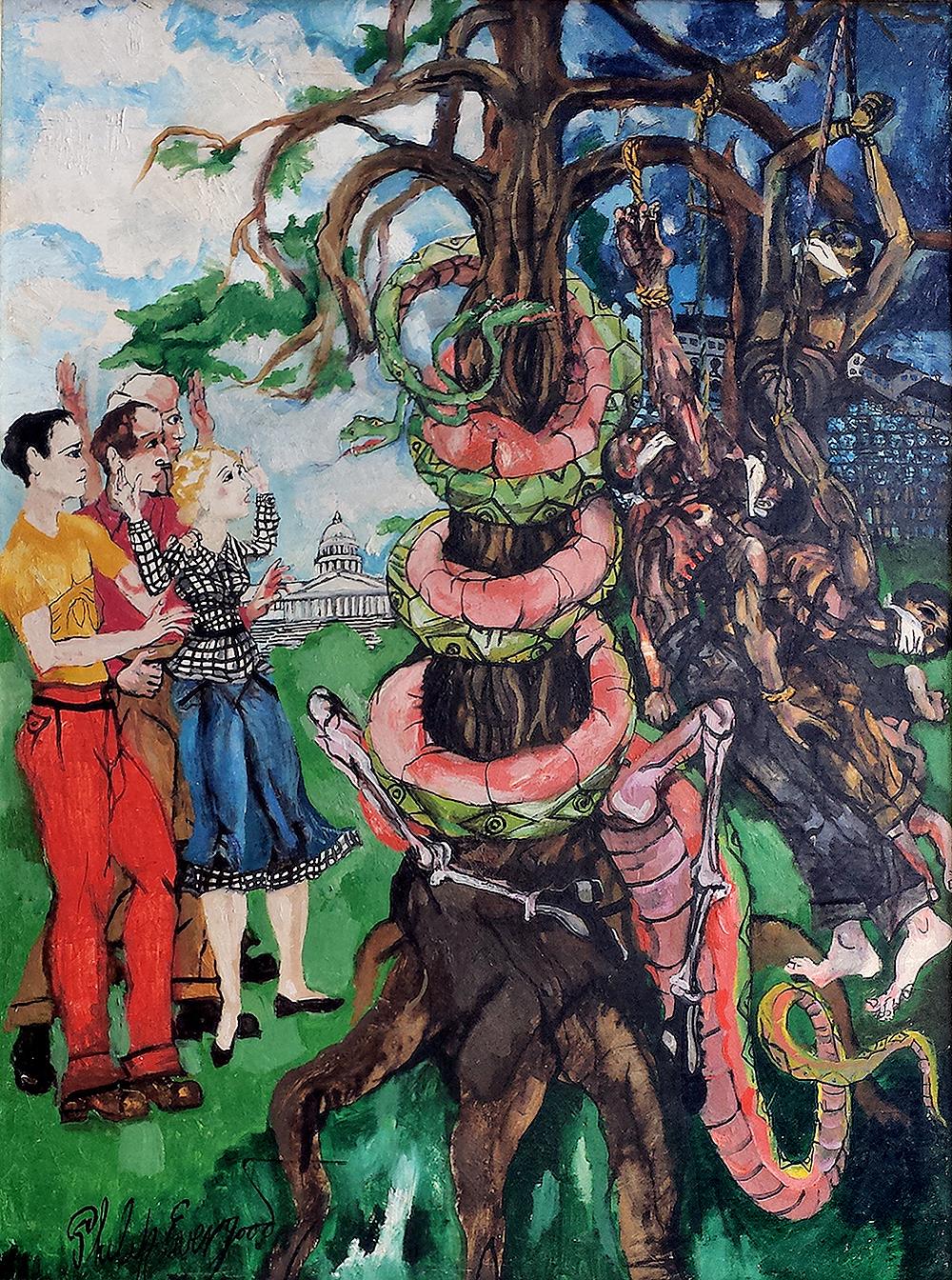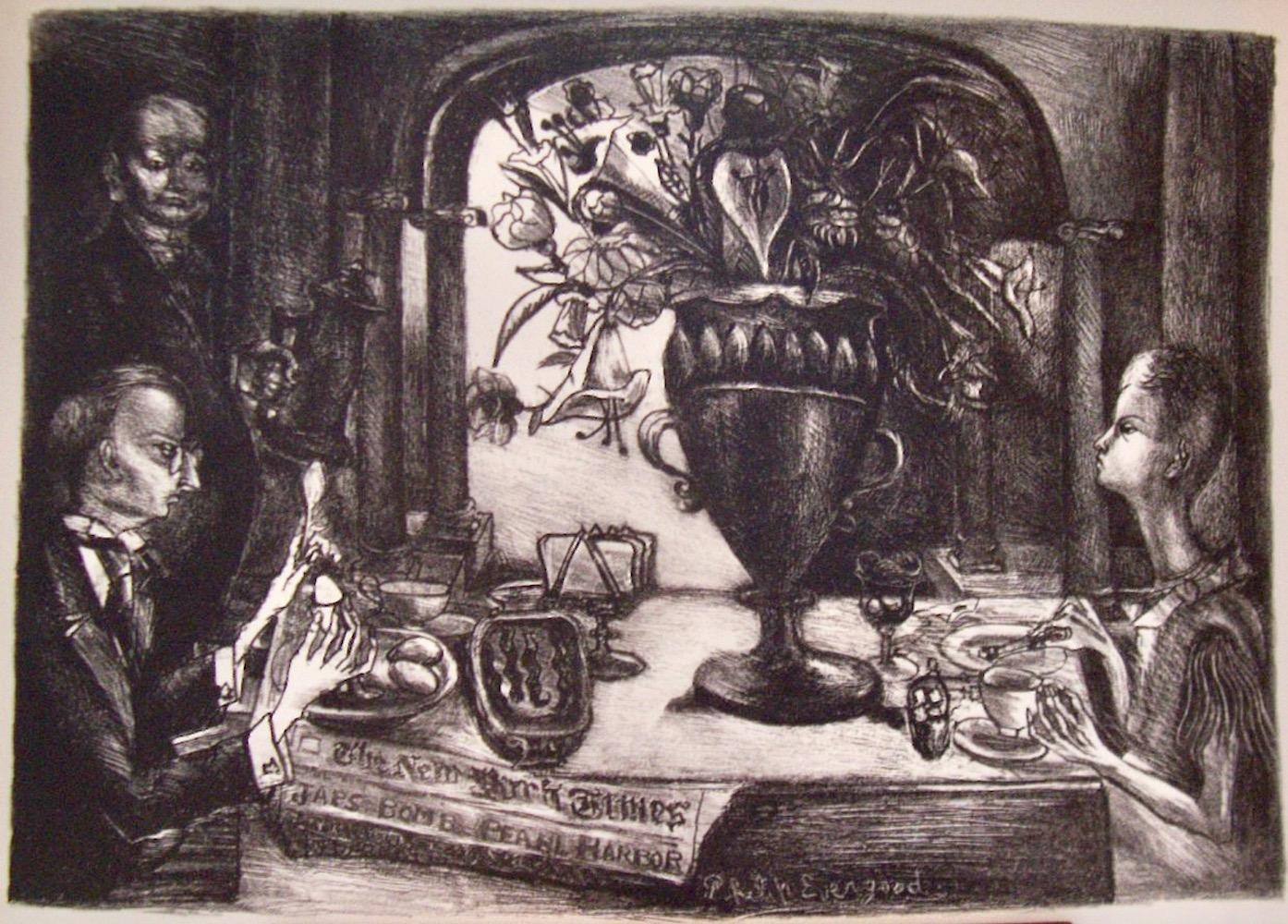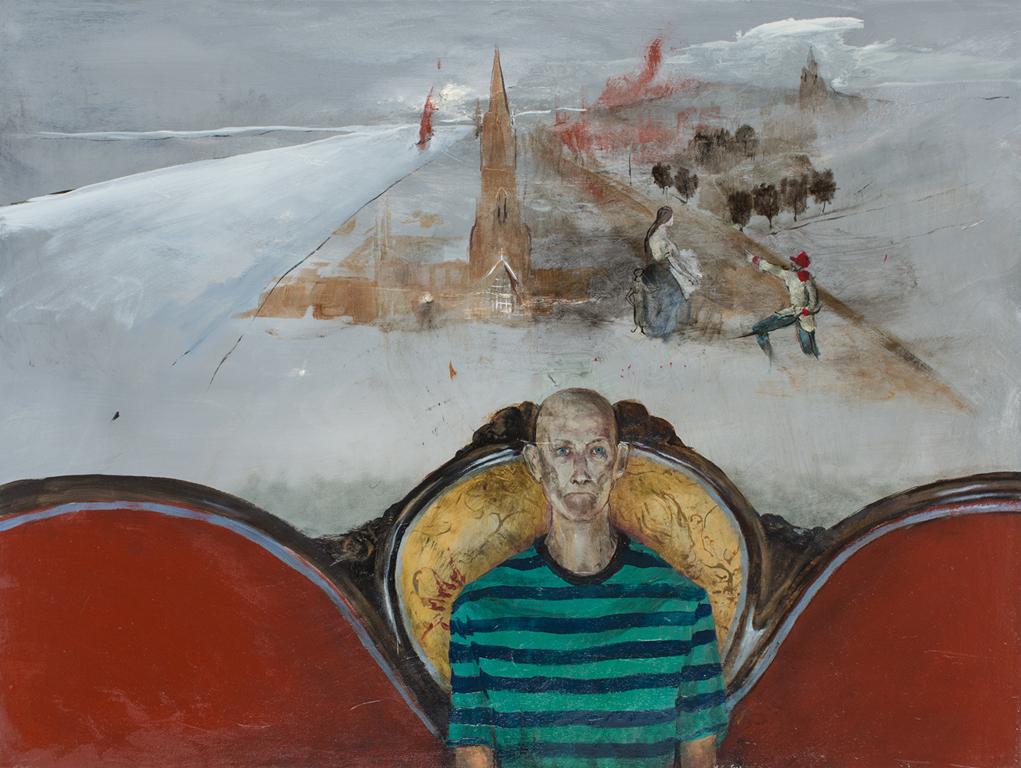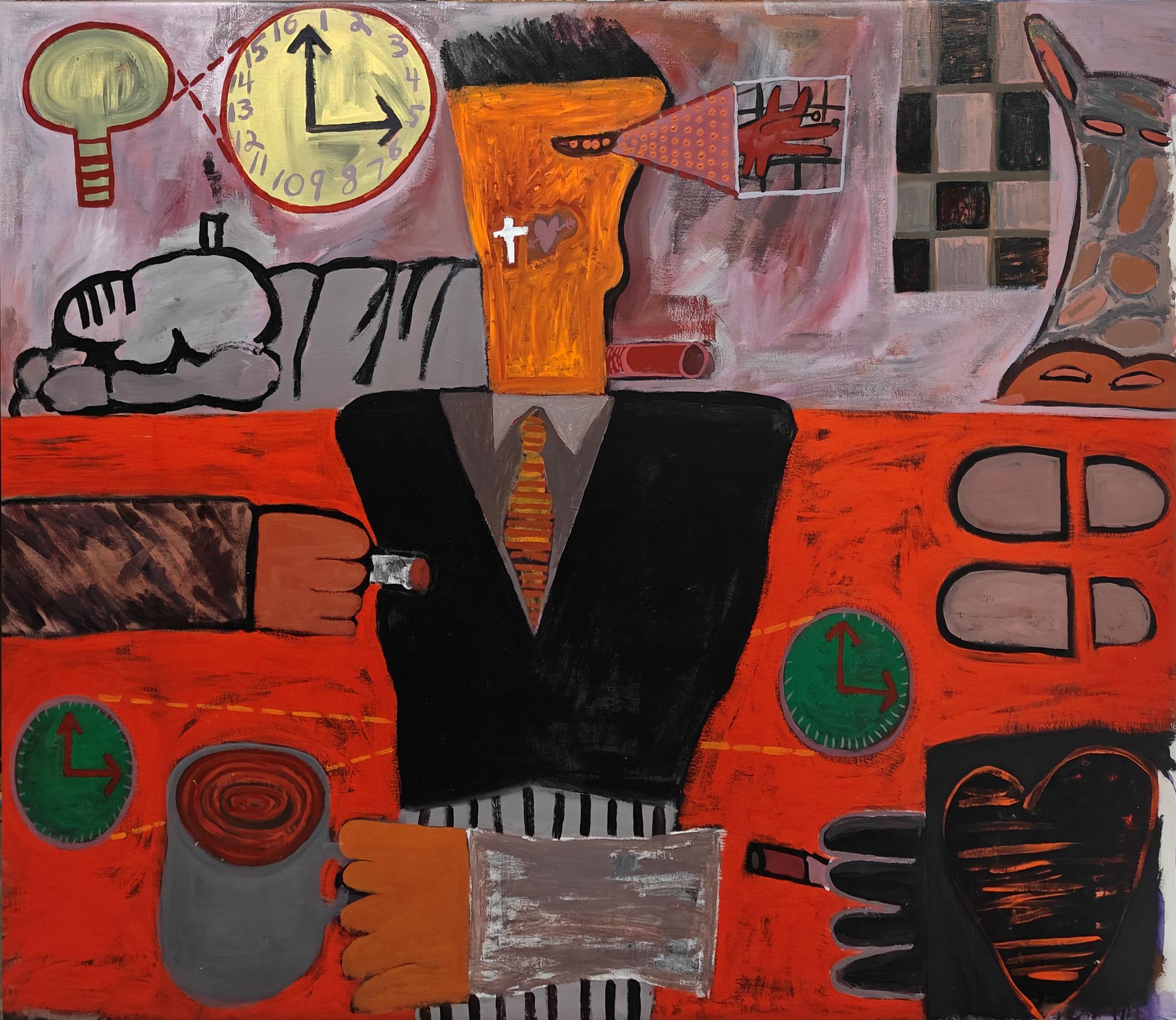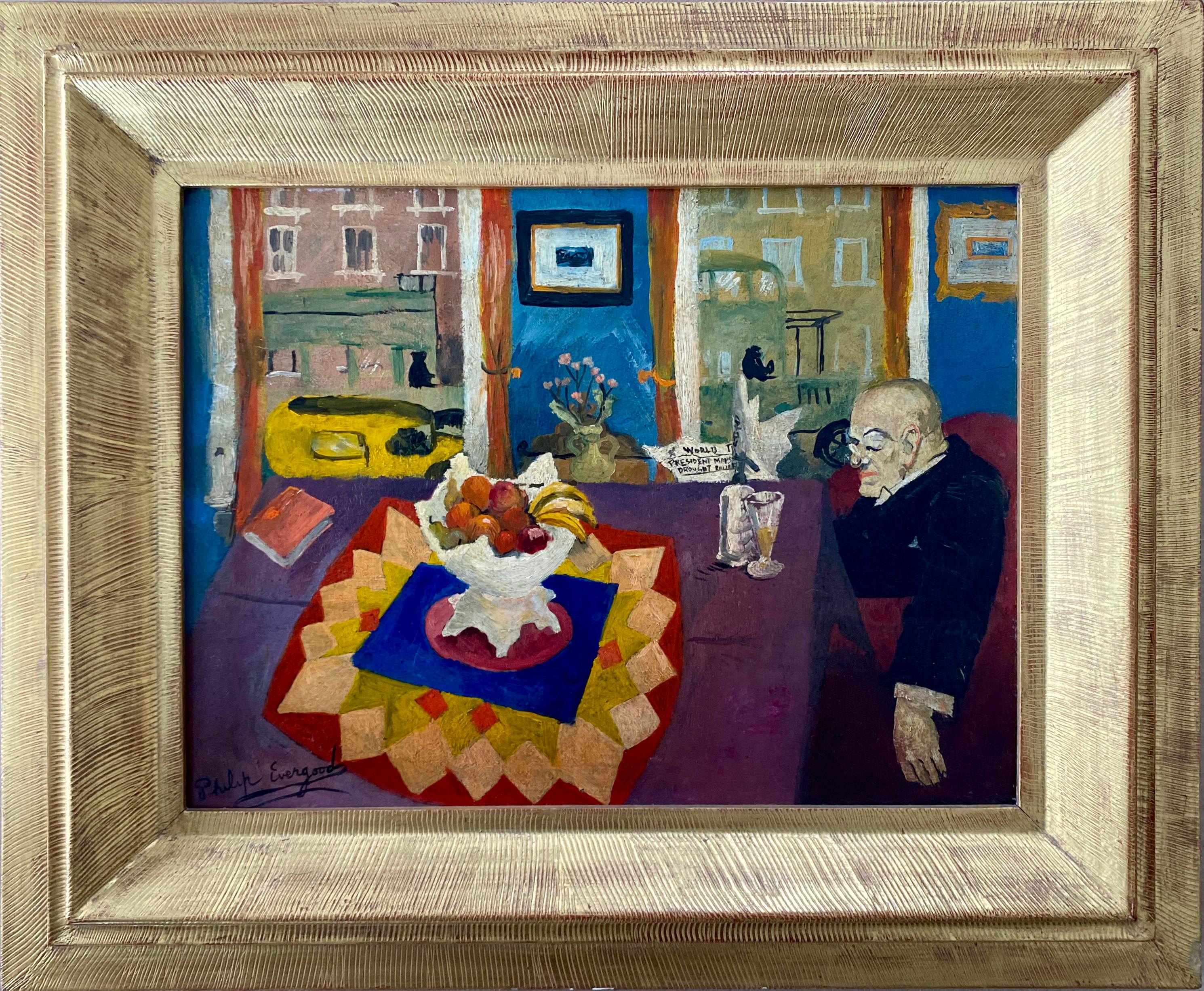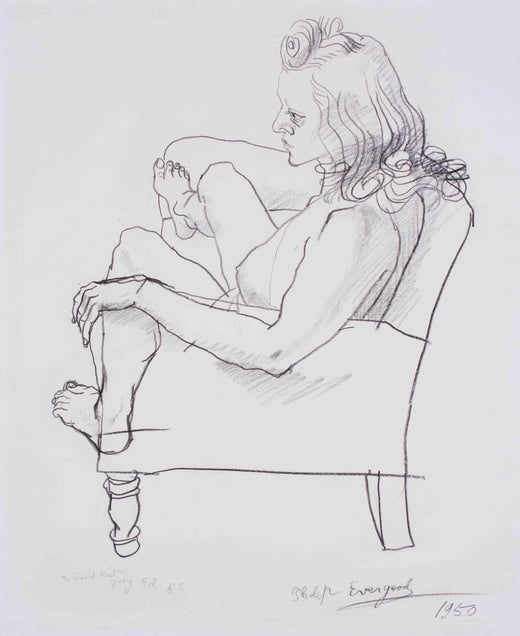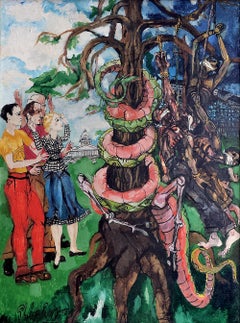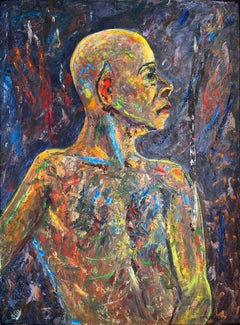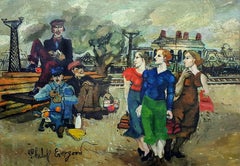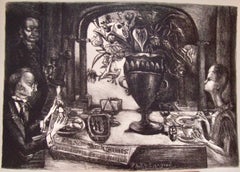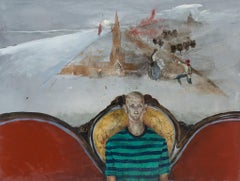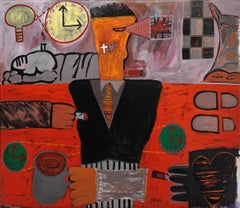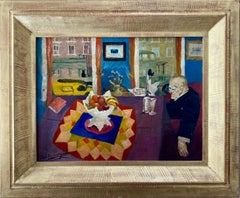Items Similar to untitled ( Civil Rights )
Want more images or videos?
Request additional images or videos from the seller
1 of 20
Philip Evergooduntitled ( Civil Rights )1958
1958
$110,000
£83,511.47
€95,701.66
CA$156,130.45
A$170,298.84
CHF 89,462.33
MX$2,060,266.89
NOK 1,119,203.19
SEK 1,056,750.54
DKK 714,346.99
About the Item
Evergood is decades ahead of his time in shouting out against racial injustice. Painted in the late 1950's KKK is an important work. For Philip Evergood (born Philip Blashki), painting was a form of social protest. In 1923, he studied at the Art Students League under George Luks, where he began painting contemporary life with artists John Sloan and Reginald Marsh. But it was the Great Depression that inspired the most drastic change in the artist’s oeuvre, as he turned to drawing horrific scenes of poverty directly from the city’s streets. At the same time, he became an advocate for social change, serving as managing supervisor of the New York WPA easel project and president of the Artists Union. More concerned with conveying emotion than beautiful composition, and influenced by El Greco, Paul Cézanne, and the Surrealists, he used what he described as “the nasty color or sickly color, the sweet color or violent color or pretty-pretty-dolly color that will express the mood of what I’m trying to put over.”
- Creator:Philip Evergood (1901-1973, American)
- Creation Year:1958
- Dimensions:Height: 25 in (63.5 cm)Width: 25 in (63.5 cm)
- Medium:
- Movement & Style:
- Period:
- Condition:
- Gallery Location:Miami, FL
- Reference Number:1stDibs: LU38533358393
Philip Evergood
Philip Evergood was an American Social Realist painter. An advocate for civil rights, much of his work depicted the daily lives of working-class people, as seen in his hallmark piece, Sunnyside of the Street (1950). “Actually if you paint a group of country folk having a feast like Brueghel did it's social painting, too,” the artist said. “But then when you get down to paintings like The Massacre of the Innocents (1566) by Brueghel when Holland was occupied by the Spanish and you have people smashing doors down and bringing out infants and cutting them in half with swords then you're doing a very brave kind of social statement.” Born Howard Blashki in 1901 in New York, NY, his father was the Australian landscape painter Miles Evergood. It was his father that anglicized the family name from the Jewish-Polish Blashki to Evergood, when Philip was a child. Moving with his parents to London in 1909, he went on to study at Eton College and Cambridge University. Set on pursuing a career in art he enrolled at the Slade School of Fine Art, studying under Henry Tonks. Returning to New York in 1923, he studied with the Ashcan School painter George Luks. During the Great Depression, the artist worked for the WPA, creating murals in both Queens, NY, and Jackson, GA. Evergood died in 1973 in Bridgewater, CT. Today, his works are included in the collections of the Art Institute of Chicago, The Museum of Modern Art in New York, the National Gallery of Art in Washington, D.C., and the Los Angeles County Museum of Art.

About the Seller
5.0
Gold Seller
Premium sellers maintaining a 4.3+ rating and 24-hour response times
Established in 2005
1stDibs seller since 2016
117 sales on 1stDibs
Typical response time: <1 hour
- ShippingRetrieving quote...Shipping from: Miami, FL
- Return Policy
Authenticity Guarantee
In the unlikely event there’s an issue with an item’s authenticity, contact us within 1 year for a full refund. DetailsMoney-Back Guarantee
If your item is not as described, is damaged in transit, or does not arrive, contact us within 7 days for a full refund. Details24-Hour Cancellation
You have a 24-hour grace period in which to reconsider your purchase, with no questions asked.Vetted Professional Sellers
Our world-class sellers must adhere to strict standards for service and quality, maintaining the integrity of our listings.Price-Match Guarantee
If you find that a seller listed the same item for a lower price elsewhere, we’ll match it.Trusted Global Delivery
Our best-in-class carrier network provides specialized shipping options worldwide, including custom delivery.More From This Seller
View AllCivil Rights, Racial Justice Little Rock
By Philip Evergood
Located in Miami, FL
"Civil Rights." Evergood's early commentary on racial issues in the 1950s depicts four black men gagged, roped and hanging from a tree. In the background, imprisoned blacks look on through a barbed-wire fence. Whites watch in horror but do nothing to help. Meanwhile, a two-legged and three-headed serpent who symbolizes evil - wraps himself around the tree that physically and symbolically separates the races. This is an important work in the history of American art. It may be one of the very earliest examples of a major American painter doing a major work that challenges racial segregation and injustice at a time when no one else would. The title of the work is inspired by a Historic Supreme Court decision on racial segregation. The Little Rock...
Category
1950s American Realist Figurative Paintings
Materials
Oil
Philip Evergood, Little Rock, Oil on Canvas, 1955 - "Civil Rights."
By Philip Evergood
Located in Miami, FL
"Civil Rights." Evergood's early commentary on racial issues in the 1950s depicts four black men gagged, roped and hanging from a tree. In the background, imprisoned blacks look on through a barbed-wire fence. Whites watch in horror but do nothing to help. Meanwhile, a two-legged and three-headed serpent wraps himself around the tree that physically and symbolically separates the races. This is an important work in the history of American art. It may be one of the very earliest examples of a major American painter doing a major work that challenges racial segregation and injustice at a time when no one else would. The title of the work is inspired by a Historic Supreme Court decision on racial segregation. The Little Rock...
Category
1950s American Realist Figurative Paintings
Materials
Oil
Devil: No Horns, Burning in Hell, African American Harlem Renaissance
Located in Miami, FL
In a 1971 interview with Ebony Magazine, Alvin Hollinsworth commented on his African Jesus Christ painting, "I have always felt that Christ was a Blac...
Category
1970s Expressionist Figurative Paintings
Materials
Masonite, Oil
Railroad Men's Wives - American Scene Painting - Social Realism
By Philip Evergood
Located in Miami, FL
American Scene Painting - Social Realism. The present work is a Depression Era account of working-class men and women.
Philip Howard Francis Dixon Evergood (born Howard Blashki; 190...
Category
1930s Expressionist Figurative Paintings
Materials
Oil
Black Panther Trials - Civil Rights Movement Police Violence African American
Located in Miami, FL
The Black Panther Trials - In this historically significant work, African American Artist Vicent D. Smith functions as an Art Journalist/ Court Reporter as much as a
Artist. Here, he depicts, in complete unity, 21 Black Panther Protestors raising their fist of defiance at the White Judge. Smith's composition is about utter simplicity, where the Black Panther Protestors are symmetrically lined up in a confrontation with a Judge whose size is exaggerated in scale. Set against a stylized American Flag, the supercilious Judge gazes down as the protesters as their fists thrust up. Signed Vincent lower right. Titled Panter 21. Original metal frame. Tape on upper left edge of frame. 255 . Panther 21. Framed under plexi.
_____________________________
From Wikipedia
In 1969-1971 there was a series of criminal prosecutions in New Haven, Connecticut, against various members and associates of the Black Panther Party.[1] The charges ranged from criminal conspiracy to first-degree murder. All charges stemmed from the murder of 19-year-old Alex Rackley in the early hours of May 21, 1969. The trials became a rallying-point for the American Left, and marked a decline in public support, even among the black community, for the Black Panther Party
On May 17, 1969, members of the Black Panther Party kidnapped fellow Panther Alex Rackley, who had fallen under suspicion of informing for the FBI. He was held captive at the New Haven Panther headquarters on Orchard Street, where he was tortured and interrogated until he confessed. His interrogation was tape recorded by the Panthers.[2] During that time, national party chairman Bobby Seale visited New Haven and spoke on the campus of Yale University for the Yale Black Ensemble Theater Company.[3] The prosecution alleged, but Seale denied, that after his speech, Seale briefly stopped by the headquarters where Rackley was being held captive and ordered that Rackley be executed. Early in the morning of May 21, three Panthers – Warren Kimbro, Lonnie McLucas, and George Sams, one of the Panthers who had come East from California to investigate the police infiltration of the New York Panther chapter, drove Rackley to the nearby town of Middlefield, Connecticut. Kimbro shot Rackley once in the head and McLucas shot him once in the chest. They dumped his corpse in a swamp, where it was discovered the next day. New Haven police immediately arrested eight New Haven area Black Panthers. Sams and two other Panthers from California were captured later.
Sams and Kimbro confessed to the murder, and agreed to testify against McLucas in exchange for a reduction in sentence. Sams also implicated Seale in the killing, telling his interrogators that while visiting the Panther headquarters on the night of his speech, Seale had directly ordered him to murder Rackley. In all, nine defendants were indicted on charges related to the case. In the heated political rhetoric of the day, these defendants were referred to as the "New Haven Nine", a deliberate allusion to other cause-celebre defendants like the "Chicago Seven".
The first trial was that of Lonnie McLucas, the only person who physically took part in the killing who refused to plead guilty. In fact, McLucas had confessed to shooting Rackley, but nonetheless chose to go to trial.
Jury selection began in May 1970. The case and trial were already a national cause célèbre among critics of the Nixon administration, and especially among those hostile to the actions of the FBI. Under the Bureau's then-secret "Counter-Intelligence Program" (COINTELPRO), FBI director J. Edgar Hoover had ordered his agents to disrupt, discredit, or otherwise neutralize radical groups like the Panthers. Hostility between groups organizing political dissent and the Bureau was, by the time of the trials, at a fever pitch. Hostility from the left was also directed at the two Panthers cooperating with the prosecutors. Sams in particular was accused of being an informant, and lying to implicate Seale for personal benefit.
In the days leading up to a rally on May Day 1970, thousands of supporters of the Panthers arrived in New Haven individually and in organized groups. They were housed and fed by community organizations and by sympathetic Yale students in their dormitory rooms. The Yale college dining halls provided basic meals for everyone. Protesters met daily en masse on the New Haven Green across the street from the Courthouse (and one hundred yards from Yale's main gate). On May Day there was a rally on the Green, featuring speakers including Jean Genet, Abbie Hoffman, Jerry Rubin, and John Froines (an assistant professor of chemistry at the University of Oregon). Teach-ins and other events were also held in the colleges themselves.
Towards midnight on May 1, two bombs exploded in Yale's Ingalls Rink, where a concert was being held in conjunction with the protests.[4] Although the rink was damaged, no one was injured, and no culprit was identified.[4]
Yale chaplain William Sloane Coffin stated, "All of us conspired to bring on this tragedy by law enforcement agencies by their illegal acts against the Panthers, and the rest of us by our immoral silence in front of these acts," while Yale President Kingman Brewster Jr. issued the statement, "I personally want to say that I'm appalled and ashamed that things should have come to such a pass that I am skeptical of the ability of a Black revolutionary to receive a fair trial anywhere in the U.S." Brewster's generally sympathetic tone enraged many of the university's older, more conservative alumni, heightening tensions within the school community.
As tensions mounted, Yale officials sought to avoid deeper unrest and to deflect the real possibility of riots or violent student demonstrations. Sam Chauncey has been credited with winning tactical management on behalf of the administration to quell anxiety among law enforcement and New Haven's citizens, while Kurt Schmoke, a future Rhodes Scholar, mayor of Baltimore, MD and Dean of Howard University School of Law, has received kudos as undergraduate spokesman to the faculty during some of the protest's tensest moments. Ralph Dawson, a classmate of Schmoke's, figured prominently as moderator of the Black Student Alliance at Yale (BSAY).
In the end, compromises between the administration and the students - and, primarily, urgent calls for nonviolence from Bobby Seale and the Black Panthers themselves - quashed the possibility of violence. While Yale (and many other colleges) went "on strike" from May Day until the end of the term, like most schools it was not actually "shut down". Classes were made "voluntarily optional" for the time and students were graded "Pass/Fail" for the work done up to then.
Trial of McLucas
Black Panther trial sketch...
Category
1970s American Modern Figurative Drawings and Watercolors
Materials
Watercolor, Pen, Pencil, Paper
Street Life New York - Haunting Faces Windows Expressionism Mid-Century
By Lawrence Kupferman
Located in Miami, FL
Mid-century artist Lawrence Kupferman paints a madly eerie New York street scene. An exaggerated upward view of two 19th-century walk-ups is split by a forced perspective of a downwa...
Category
1940s Expressionist Figurative Drawings and Watercolors
Materials
Paper, Ink, Watercolor, Pen
You May Also Like
Philip Evergood, (The New York Times)
By Philip Evergood
Located in New York, NY
The ever-quirky Philip Evergood has composed a print that is at once a World War II image (The New York Times on the table has the headline 'Japs Bomb P...
Category
Mid-20th Century Ashcan School Figurative Prints
Materials
Lithograph
Mississippi Burning
By Miles Cleveland Goodwin
Located in Dallas, TX
In Miles Cleveland Goodwin’s soulful compositions, he narrates the story of his life. Goodwin responds to his environment, the lives of common folk living around him, and the mysteri...
Category
2010s Contemporary Figurative Paintings
Materials
Canvas, Oil
"Untitled" Lawrence Philp, Abstracted Surrealist Forms by Afro-American Artist
Located in New York, NY
Lawrence Philp
Untitled
Oil and acrylic on canvas
75 1/2 x 79 inches
Lawrence Philp, the son of Jamaican immigrants, studied at the Rhode Island School of Design and was included i...
Category
1970s Post-Modern Abstract Paintings
Materials
Canvas, Oil, Acrylic
Philip Evergood American Modernism WPA Social Realism Modern Still Life Interior
By Philip Evergood
Located in New York, NY
Interior with Man at Table American Modernism WPA Social Realism Modern Painting
Philip Evergood (1901 - 1973) Untitled (Interior with Man at ...
Category
1930s American Modern Figurative Paintings
Materials
Oil, Panel
Large Expressionist Figurative Oil Painting "Witnesses"
By André François van Vuuren
Located in Cape Town, ZA
This oil painting on Belgian linen canvas depicts people and situations with whom the artist have had contact. Whilst the works are not strictly speaking, portraits of specific peopl...
Category
2010s Contemporary Figurative Paintings
Materials
Linen, Oil
$13,871 Sale Price
20% Off
"You Got Me"- Richly Colorful Abstract/Figurative Mixed Media Painting
Located in Brooklyn, NY
From the tender age of eight, John-Herbert Wright gravitated to painting as an escape expressing a rich inner world. His work heavily relies upon dark figurations amongst an urban l...
Category
2010s Contemporary Paintings
Materials
Canvas, Mixed Media, Latex
